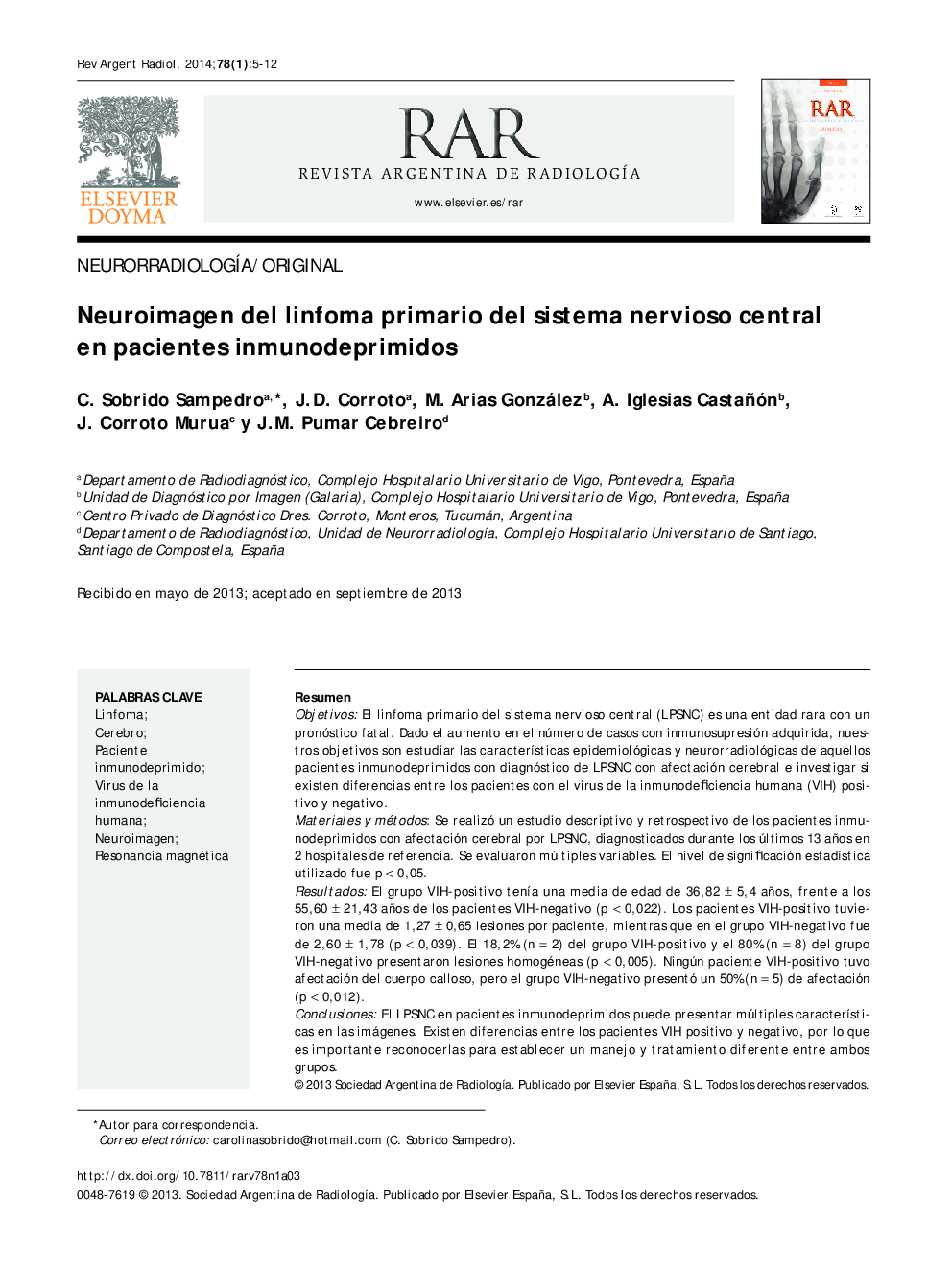| Article ID | Journal | Published Year | Pages | File Type |
|---|---|---|---|---|
| 4248625 | Revista Argentina de Radiología | 2014 | 8 Pages |
ResumenObjetivosEl linfoma primario del sistema nervioso central (LPSNC) es una entidad rara con un pronóstico fatal. Dado el aumento en el número de casos con inmunosupresión adquirida, nuestros objetivos son estudiar las características epidemiológicas y neurorradiológicas de aquellos pacientes inmunodeprimidos con diagnóstico de LPSNC con afectación cerebral e investigar si existen diferencias entre los pacientes con el virus de la inmunodeficiencia humana (VIH) positivo y negativo.Materiales y métodosSe realizó un estudio descriptivo y retrospectivo de los pacientes inmunodeprimidos con afectación cerebral por LPSNC, diagnosticados durante los últimos 13 años en 2 hospitales de referencia. Se evaluaron múltiples variables. El nivel de significación estadística utilizado fue p < 0,05.ResultadosEl grupo VIH-positivo tenía una media de edad de 36,82 ± 5,4 años, frente a los 55,60 ± 21,43 años de los pacientes VIH-negativo (p < 0,022). Los pacientes VIH-positivo tuvieron una media de 1,27 ± 0,65 lesiones por paciente, mientras que en el grupo VIH-negativo fue de 2,60 ± 1,78 (p < 0,039). El 18,2% (n = 2) del grupo VIH-positivo y el 80% (n = 8) del grupo VIH-negativo presentaron lesiones homogéneas (p < 0,005). Ningún paciente VIH-positivo tuvo afectación del cuerpo calloso, pero el grupo VIH-negativo presentó un 50% (n = 5) de afectación (p < 0,012).ConclusionesEl LPSNC en pacientes inmunodeprimidos puede presentar múltiples características en las imágenes. Existen diferencias entre los pacientes VIH positivo y negativo, por lo que es importante reconocerlas para establecer un manejo y tratamiento diferente entre ambos grupos.
PurposesPrimary central nervous system lymphoma (PCNSL) is a rare tumour with poor prognosis. Due to the increased number of patients with acquired immunodeficiency, our purposes are to describe epidemiological and imaging findings in immunodeficient patients with PCNSL of the brain and to study the differences between HIV-positive and HIV-negative patients with PCNSL.Materials and methodsA retrospective, descriptive study was performed with immunodeficient patients diagnosed of PCNSL of the brain during the last 13 years in two reference hospitals. Twenty-one patients fulfilled the inclusion criteria. Multiple variables were evaluated. Significance was defined as p<0.05.ResultsHIV-positive group was a mean age of 36,82 ± 5,4 years and the mean age in HIV-negative group was 55,60 ± 21,43 years (p < 0,022). The mean number of lesions was 1,27 ± 0,65 in HIV-positive group and 2,60 ± 1,78 in HIV-negative group (p < 0,039). The lesions were homogeneous in 18,2% (n = 2) HIV-positive group and 80% (n = 8) in HIV-negative group (p < 0,005). No HIV-positive patient and 50% (n = 5) of HIV-negative patients showed corpus callosum involvement (p < 0,012).ConclusionsPCNSL in immunodeficient patients is associated with a large spectrum of radiological findings. There were differences between HIV-positive and HIV-negative patients, is important recognize these differences as the therapeutic management of these two groups vary.
